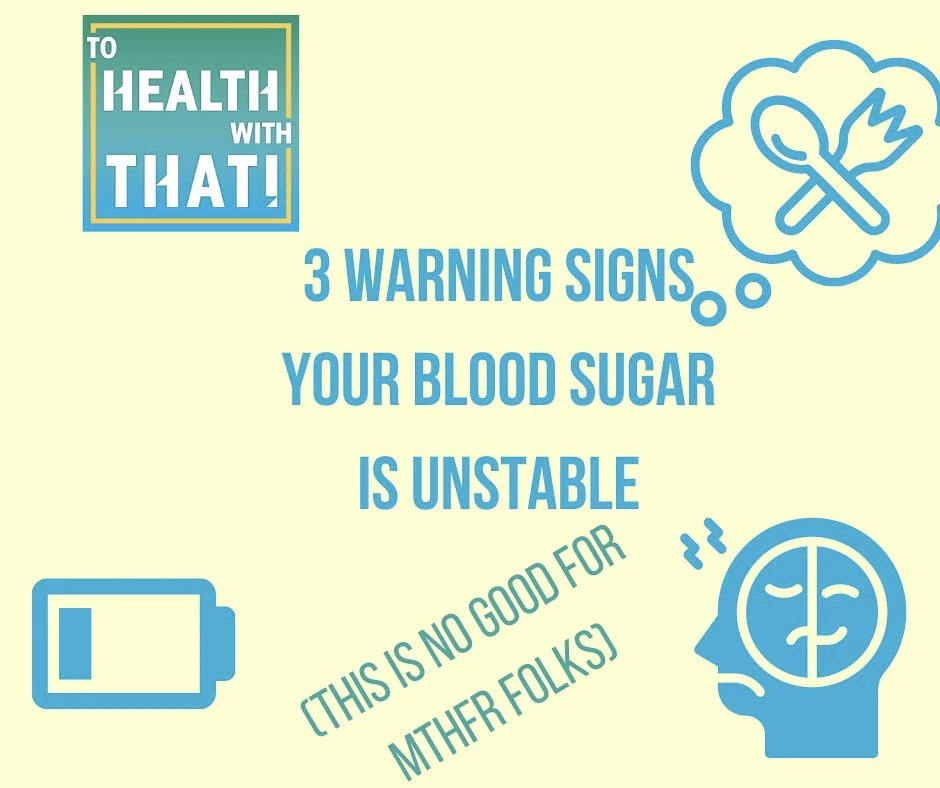Unstable blood sugar is embedded deep within the foundation of so many modern problems. Obesity, metabolic syndrome, pre-diabetes, diabetes. I’m guessing you knew all of that, but what about the link between blood sugar and anxiety? Unstable blood sugar and mood swings? Unstable blood sugar and fatigue? I mean, who doesn’t have fatigue these days?
The Link Between MTHFR and Unstable Blood Sugar
People with the MTHFR polymorphism are even more susceptible to unstable blood sugar, insulin resistance, metabolic syndrome, and type two diabetes than average, so it is important to think of blood sugar in your MTHFR diet plan. Studies have shown that both heterozygous (one variant copy) and homozygous (two variant copies) of the C677T gene are associated with a higher risk of developing type 2 diabetes. MTHFR polymorphisms have also been associated with a higher risk of gestational diabetes, which can indicate a tendency toward blood sugar instability overall.
The Standard American Diet and Unstable Blood Sugar
The standard north american diet tends to be heavy on the carbohydrates. Bread, cereal, pasta, pastries, bagels, fries, potatoes, and rice are dietary staples and most meals include a generous helping of at least one of these things. Not to mention the big-as-your-face sweetened coffee concoction on the way to work, often without breakfast or with something pastry-like, and the mid-afternoon soda pick-me-up. While nobody is arguing that carbs taste great and everybody loves them, they don’t help with the epidemic of blood sugar issues that we’re facing today.
With this in mind, let’s dive in to the three biggest signs that your blood sugar is unstable. If you have any one of these signs or indicators, consider trying a low-glycemic index diet for two weeks and tracking your symptoms – especially that indicator symptom – to see what changes. You will be blown away by the results.

Unstable Blood Sugar Sign #1: Mood Swings
Sure, sure, you’re just a moody person. Maybe that is true, but there is no doubt you’d be less moody if your blood sugar stayed relatively stable. As your blood sugars rise, you tend to have more happy neurotransmitters, more endorphins, and a generally better mood. When they fall, that mood gets darker, lower, and generally worse. This could look like sadness, it could look like anxiety (having low blood sugar is actually life threatening, so a bit of anxiety is a completely natural reaction), and it could look like irritability. If your blood sugar plummets, then it can look like outright aggression or a panic attack. So yes, some people do have more changeable moods, but a lot of the changeability can be smoothed out with balanced blood sugars.
Unstable Blood Sugar Sign #2: Sudden Fatigue
If your blood sugars drop quickly, your body gets all the shut-down signals. This means your energy suddenly falls out from under you and you hit a wall. I’ve heard many people say, “no, it can’t be blood sugar because I get tired at 3:00 pm pretty much every day.” Of course, they could be right – there are other causes of sudden fatigue like medications wearing out, adrenal issues, and over stress, but most of the people who say that also eat similar meals most days. They have their food routines and often the way they eat is leading to a predictable time every day when their blood sugar runs out. So if you’re having a sudden bout of fatigue, even if you’ve had that same kind of fatigue every day for the last five years, it could still be falling blood sugars. Focus on taking the key steps to make your diet conducive to stable blood sugars and track your energy and your “sinking spells” over the next few weeks. Stabilizing your blood sugars might not make the problem go away completely, but it will almost certainly make it much better.
Some people, especially younger people, notice this more as a sudden inability to concentrate or focus, rather than fatigue. This is the same process at work, a sudden drop in the amount of useable blood sugar to the brain and so in reality, both cognition and energy are impaired.
The best diet to help you balance blood sugars is a low-glycemic index Mediterranean diet, which happens to also be the best type of diet for folks with the MTHFR polymorphism, so we’ll be talking about it in the next few posts.
Unstable Blood Sugar Sign #3: Between Meal Hunger or Not Feeling Full
Occasional between-meal hunger is normal, especially if you just joined a pick-up rugby game or decided to spontaneously walk the mile and a half to work instead of hopping in the car. Changes like that can change your blood sugar significantly, and are outside of your normal routine. For the most part, your meals should give you a full feeling and last about four hours. Now, I know many people think they’re snackers – they just need frequent food and that’s how they’ve always been. There is a small percentage of people with such fast metabolisms that this is truly the case and they may need meals more frequently, but for most people it’s a sign that your blood sugar has dropped before it should.
Many of you have probably noticed the obvious thing I’m overlooking, which is that something like, say, sugary breakfast cereal, is into your blood stream and all used up 20 minutes after putting down your spoon. I have to point out the obvious here, which is that if your breakfast was sugary cereal, your blood sugar is, by definition, unstable. Why? Because you ate sugar and starch for breakfast and nothing else, and unless you’re some kind of blood-sugar stability god, that isn’t going to keep blood sugar around at all.
Fixing Unstable Blood Sugar: Low Glycemic Index Eating
If you are experiencing any of the big warning signs of unstable blood sugar like mood swings, sudden fatigue, or hunger between meals, then it’s time to adopt a low glycemic index diet. Also, if you have any of the risk factors for blood sugar issues like MTHFR polymorphism, family history of diabetes, obesity, insulin resistance, PCOS, metabolic syndrome, or if you notice you’re gaining weight around your belly more than anywhere else, then a low glycemic index diet is the thing for you. We will discuss low glycemic index eating in the next post.

Learn more about the perfect diet for an MTHFR variant in the MTHFR Diet course. Optimize your energy, productivity, focus and mental health by eating the right foods for your genes. Reduce your long-term risk and feel better, fast. Learn more and sign up here.
MTHFR is a common genetic mutation that can contribute to anxiety, depression, fatigue, chronic pain, infertility, and more serious conditions like breast implant illness, heart attack, stroke, chronic fatigue syndrome, and some types of cancer. If you know or suspect you have an MTHFR variant, schedule a free 15-minute meet-and-greet appointment with MTHFR expert Dr. Amy today.
Book Your Appointment
